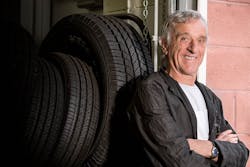Skylights, solar panels on the roof, landscaping to attract pollinators—these are just a few of the ways that British American Auto Care has differentiated itself from competitors and embraced an environmentally friendly way of doing business.
After moving to the Columbia, Md., area from England, shop owner Brian England and his wife, Jennifer, were struck by how much the community of Chesapeake Bay sought to preserve the bay’s natural habitat. It inspired a change to the way they did business that not only created a new revenue stream by making it possible for England to train more employees to work on hybrids and electric vehicles (EV), but also saved money in the long run.
From top to bottom—from energy-efficient processes and equipment to proper training to inbound marketing—England has continually added environmentally friendly features to his shop over the past 39 years in order to help the surrounding environment and turn the green additions into long-term profits.
Discovering a Passion
Despite growing up in England in the ‘60s and ‘70s, England developed a fascination with the American space race and rock ‘n’ roll music. England started working in a shop at the age of 15 and was an apprentice until he was 21 years old. Within those years, he moved between each department, learning the skills of a technician and, eventually, management.
After fulfilling his dream of moving to the U.S. in 1972, England opened British American Auto Care in 1978 as a small business with only one other employee besides him and his wife. As a 1,500-square-foot building, the facility started out with only room for five cars (the shop worked mainly on British and American vehicles) in three bays.
As the shop has expanded—it now stands at 14,000 square feet with 18 bays—so too have England’s interests. England followed in the footsteps of James Rouse, founder of the Rouse Company and urban planner and real estate developer, to profit during the recession. By caring for the environment, England was able to reduce expenses, which lowered his break-even point.
Becoming “Green”
By investing in energy-saving practices, England was able to take advantage of state and federal green initiatives to make money on EV work.
One way England embraced his environmental side from a business owner’s standpoint was through a new lighting system. He replaced 25 high-energy lamps at around 400 watts per lamp with this new smart lighting system, the Solar Light Tube Project, which has increased light within the shop tenfold. Now, when the sun rises through the day and illuminates the room through the tubes, the added 48 watts of fluorescent light bulbs blink out in twos (first six remain on, then four and then only two).
Within four years, England’s Solar Light Tube Project was paid back by reducing the energy bill around $700 per month.
Down the line, England plans to transform his waiting area into an ambient and relaxing environment similar to Starbucks, he says. He wants customers to have the option to eat lunch, work at a high table or relax in large easy chairs if they so desire.
In the fall, England will be hiring consultants to profile his team to better understand their strengths, weaknesses and how they can target more customers.
In addition to other environmentally friendly renovations, England had a specialist come into the shop and paint the walls in an epoxy reflective-light paint.
Along with other improvements to eliminate waste and keep the shop environmentally friendly and appealing, England has saved roughly $1,300 per month.
An Optimized Workspace
In order to refurbish batteries, Brian England cut down on the parts department by instead creating an in-house manufacturing set-up.
In a clean environment, the team can carry out full battery service, charge it up, stabilize the cells, discharge it and test the voltages. Fast-moving parts like oil filters, air filters and cabin filters remain in the shop but most parts are delivered by demand, England says.
He invested around $4,000 in a stainless-steel bench where his employees can work on the batteries. He was able to invest in a digital bolt meter that can read up to 5,000 bolts to recharge the batteries.
Investing in Proper Training
Those environmental efforts have also affected his vehicle mix. In recent years, England has shifted his target audience to hybrid and EV drivers.
“We wanted to go after this service. We see quite an opportunity there,” England says. “People who own these cars are very thrifty. It's not just about the environment. It's about saving money.”
To pivot his business, he started by sending his employees to training for 40 hours per year under a training budget of around $20,000–$30,000. To send his two technicians for training in EV repair, he spends roughly $9,000 for one week of training.
In order to solve the problems that arise with EVs, England has sent his employees to training provided by the Automotive Career Development Center since 2000. His employees attend a five-day course.
“You can’t half do it. If you’re going to do it, you need one or two people really trained to understand this thing front to back,” England says. “It's really about understanding the battery technology and being able to repair the batteries ourselves. We've seen some of the remanufactured ones and, really, what they're doing, we can do.”
Employees also attend training through an ACDelco Professional Service Center Program, in which they get free training and provide the instructors with an in-shop lunch, England says.
Winning Over Customers
On top of saving money each month without high-energy lamps, England profits by selling his solar energy, he says. For selling his solar energy panel credits, he might get back as much as $50–$200 per megawatt.
To England, EVs are not just valuable for the environment but also for saving money.
“People who own these cars are very thrifty,” he says.
In order to reach out to the modern vehicle owner—the EV and hybrid vehicle enthusiasts—England started a blog. Now, the blog reaches 1.2 million people per year. For new customers entering British American Auto Care, he says many of them found the shop through a Google search that brought up the shop as “best hybrid vehicle shop in town.” England addresses customer concerns and questions through the blog.
“It’s called inbound marketing,” England says. “This is marketing that comes to you.”
Not only did England reach out to customers via the internet, but also showcased cells in an open battery at a local environmental fair, GreenFest.
England is looking to capitalize on his momentum and purchase a Chevrolet Bolt, an EV that runs on nickel-rich lithium-ion battery technology, as the shop’s courtesy vehicle. His plan is to continue to refine his environmental approach as the years go on, turning the all-around experience at British American Auto Care into a green one.
The Danger of Insufficient Training
Without proper training, Brian England says technicians don’t even know where to look for a problem on an electric vehicle (EV).
If the battery in an EV were to overheat, he says an untrained technician might condemn the battery as faulty before they even check it for a filter that clears the air. The battery might get clogged, but the untrained technician would have no idea where to check, resulting in dangerous repairs and comebacks, England says.
“It's not that complex,” he says. “We dismantle it, check each of the cells, charge the cells, stabilize the battery, replace the cells—we can do all those things.”

